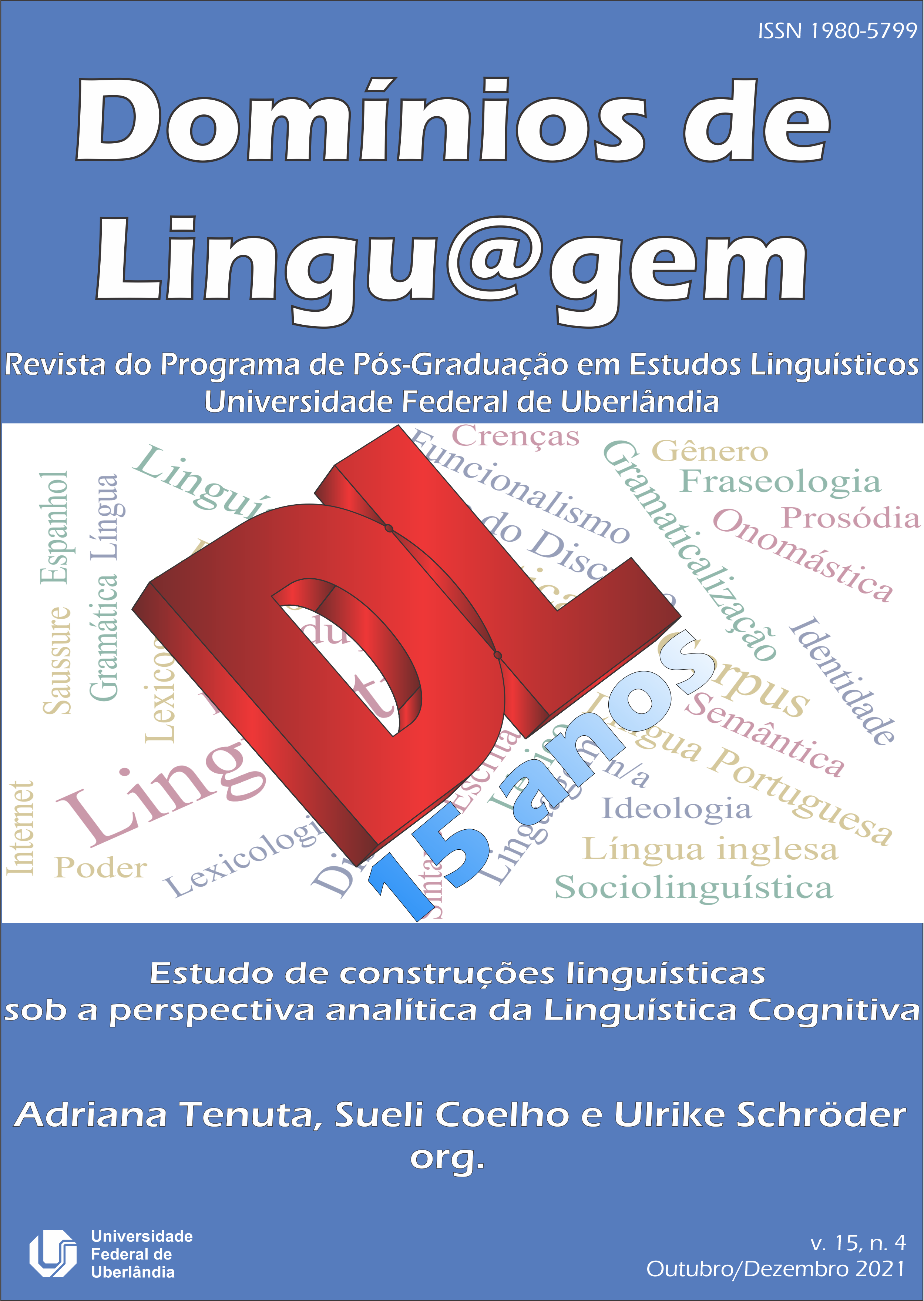Estudo de construções linguísticas sob a perspectiva analítica da Linguística Cognitiva
DOI:
https://doi.org/10.14393/DL48-v15n4a2021-1Palavras-chave:
Linguística CognitivaResumo
Apresentação
Downloads
Referências
AUER, P. Construction grammar meets conversation: Einige Überlegungen am Beispiel von „so“-Konstruktionen. In: GÜNTHNER, S.; IMO, W. (org.). Konstruktionen in der Interaktion. Berlin, New York: De Gruyter, 2006. p. 291-314. DOI https://doi.org/10.1515/9783110894158.291
BARLOW, M.; KEMMER, S. (org.). Usage based models of language. Chicago: University of Chicago Press, 2000.
BYBEE, J. Language, usage and cognition. Cambridge: Cambridge University Press, 2010. DOI https://doi.org/10.1017/CBO9780511750526
BYBEE, J. Língua, uso e cognição. São Paulo: Editora Cortez, 2016.
COULSON, S. Semantic leaps: Frame-shifting and conceptual blending in meaning construction. New York: Cambridge University Press, 2001. DOI https://doi.org/10.1017/CBO9780511551352
COULSON, S. Sarcasm and the space structuring model. The literal and the nonliteral in language and thought. Berlin: Lang, 2005.
CROFT, W. Radical construction grammar: Syntactic theory in typological perspective. Oxford: Oxford University Press, 2001. DOI https://doi.org/10.1093/acprof:oso/9780198299554.001.0001
CROFT, W. Logical and typological arguments for Radical Construction Grammar. In: FRIED, M.; ÖSTMAN, J.-O. (org.). Construction grammars: Cognitive grounding and theoretical extensions. Amsterdam: John Benjamins, 2005. p. 273–314. DOI https://doi.org/10.1075/cal.3.11cro
CROFT, W. Construction grammar. In: GEERAERTS, D.; CUYCKENS, H. (org.). The Oxford handbook of cognitive linguistics. Oxford: Oxford University Press, 2007. p. 463-498.
CUNHA, M. A. F.; BISPO, E. B.; SILVA, J. R. Linguística Funcional Centrada no Uso: conceitos básicos e categorias analíticas. In: CEZARIO, M. M.; CUNHA, M. A. F. (org.). Linguística centrada no uso: uma homenagem a Mário Martelotta. Rio de Janeiro: Mauad-Faperj, 2013. p. 13-39.
DIEWALD, G. Context types in grammaticalization as constructions. Constructions. Düsseldorf, 2006. Disponível em: www.constructions-online.de:0009-4-6860. Acesso em: 10 set. 2015. DOI https://doi.org/10.1075/tsl.49.09die
DIEWALD, G. A model of relevant types of contexts in grammaticalization. In: WISCHER, I.; DIEWALD, G. (org.). New reflections on grammaticalization. Amsterdam: John Benjamins, 2002. p. 103-120.
FAUCONNIER, G.; TURNER, M. The way we think: conceptual blending and the mind’s hidden complexities. New York: Basic Books, 2002.
FILLMORE, C. J.; KAY, P.; O'CONNOR, M. C. Regularity and idiomaticity in grammatical constructions: The case of let alone. Language, 64 (3), p. 501-538, 1988. DOI https://doi.org/10.2307/414531
FILLMORE, C.; LEE-GOLDMAN, R.; RHOMIEUX, R. The FrameNet Constructicon. In: BOAS, H.; SAG, I. (org.). Sign-based construction grammar. Stanford: CSLI Publications, 2012.
FRIED, M.; ÖSTMAN, J.-O. Construction grammar and spoken language: The case of pragmatic particles. Journal of Pragmatics 37, p. 1752-1778, 2005. DOI https://doi.org/10.1016/j.pragma.2005.03.013
GEERAERTS, D.; CUYCKENS, H. Introducing cognitive linguistics. In: GEERAERTS, D.; CUYCKENS, H. (org.). The Oxford handbook of cognitive linguistics. Oxford: Oxford University Press, 2007. p. 3-21.
GOLDBERG, A. Constructions: A construction grammar approach to argument structure. Chicago: University of Chicago Press, 1995.
GOLDBERG, A. Relationships between verb and construction. In: VERSPOOR, M.; SWEETSER, E. (org.). Lexicon and grammar. Amsterdam: John Benjamins, 1998. Disponível em: https://adele.princeton.edu/files/2015/01/0098Icla.relationships.pdf. Acesso em: 11 dez. 2015.
GOLDBERG, A. Making one’s way through the data. In: SHIBATANI, M.; THOMPSON, S. A. Grammatical constructions: their form and meaning. Oxford: Oxford University Press, 1999. p. 151-173
GOLDBERG, A. Constructions at work: the nature of generalization in language. Oxford: Oxford University Press, 2006.
HOFFMANN, T. Multimodal construction grammar: From multimodal constructs to multimodal constructions. In: WEN, X.; TAYLOR, J. R. (org.). The Routledge handbook of cognitive linguistics. London, New York: Routledge, 2021. p. 78-92. DOI https://doi.org/10.4324/9781351034708-6
LAKOFF, G. Women, fire and dangerous things: What categories reveal about the mind. Chicago: University of Chicago Press, 1987. DOI https://doi.org/10.7208/chicago/9780226471013.001.0001
LANGACKER, R. W. Foundations of cognitive grammar. Volume I. Theoretical prerequisites. Stanford: Stanford University Press, 1987.
LANGACKER, R. W. A dynamic usage-based model. In: BARLOW, M.; KEMMER, S. (org.). Usage-based models of language. Stanford: CSLI Publications, 2000. p. 1-63.
LANGACKER, R. W. Cognitive grammar. In: GEERAERTS, D.; CUYCKENS, H. (org.). The Oxford handbook of cognitive linguistics. Oxford: Oxford University Press, 2007. p. 421-462.
LANGACKER, R. W. Cognitive grammar: A basic introduction. Oxford: Oxford University Press, 2008. DOI https://doi.org/10.1093/acprof:oso/9780195331967.001.0001
ROSÁRIO, I. C.; OLIVEIRA, M. R. Funcionalismo e abordagem construcional da gramática. Alfa 60 (2), p. 233-259, 2016. DOI https://doi.org/10.1590/1981-5794-1608-1
SAUSSURE, F. Curso de Linguística Geral. Tradução em Português: Antônio Chelini, José Paulo Paes e Izidoro Blikstein. São Paulo: Cultrix, 1995 (1969).
TRAUGOTT, E. C.; TROUSDALE, G. Constructionalization and constructional changes. Oxford: Oxford University Press, 2013. DOI https://doi.org/10.1093/acprof:oso/9780199679898.001.0001
Publicado
Edição
Seção
Licença
Copyright (c) 2021 Adriana Maria Tenuta, Sueli Maria Coelho, Ulrike Schröder

Este trabalho está licenciado sob uma licença Creative Commons Attribution-NonCommercial-NoDerivatives 4.0 International License.
Autores que publicam nesta revista concordam com os seguintes termos da licença Creative Commons
CC BY-NC-ND 4.0: o artigo pode ser copiado e redistribuído em qualquer suporte ou formato; os créditos devem ser dados ao autor original e mudanças no texto devem ser indicadas; o artigo não pode ser usado para fins comerciais; caso o artigo seja remixado, transformado ou algo novo for criado a partir dele, o mesmo não pode ser distribuído.
Autores têm autorização para assumir contratos adicionais separadamente, para distribuição não-exclusiva da versão do trabalho publicada nesta revista (ex.: publicar em repositório institucional ou como capítulo de livro), com reconhecimento de autoria e publicação inicial nesta revista.









